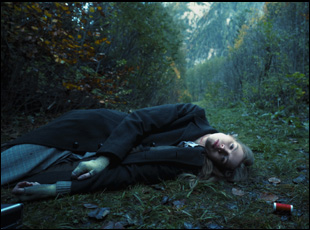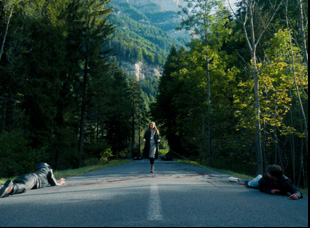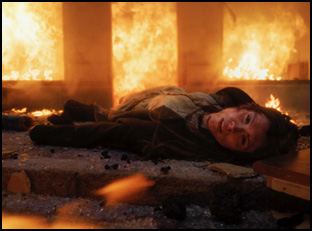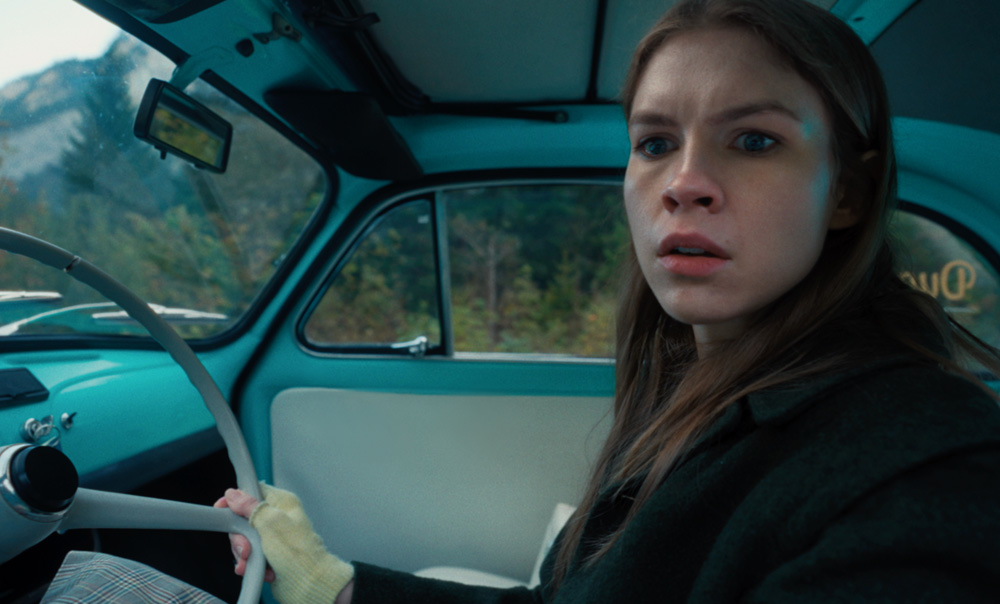For all of the complicated contraptions in “Sew Torn,” the way Freddy Macdonald’s delightful debut feature came together was relatively straightforward. Having to make a short as part of his application for AFI, MacDonald was tasked with briefly telling the story of a character who had a change of heart without using dialogue, leading to brainstorming an idea with his father of a seamstress faced with what to do upon finding a satchel full of ill-gotten cash that could go a long way towards putting her best foot forward towards the future. The short not only grabbed the attention of the acceptance board at AFI, but of various people in the industry with its dark humor and complex production prowess when anyone coming after the seamstress ended up literally tied in knots and subject to Rube Goldberg-style punishment and MacDonald had a film in theaters before starting to develop a feature of any kind after Searchlight attached the short to screenings of “Ready or Not.” No less than Joel Coen, a clear influence on MacDonald’s devious cinematic sensibilities, asked to set up a meeting in which he would tell the director barely in his twenties that he wanted to see what happened next to the seamstress, and advised, as he and his brother Ethan did for their first film, to raise money independently, so he could maintain complete creative control.
It isn’t only the freedom that approach allowed Macdonald that makes “Sew Torn” so distinctive, announcing he’s a major new talent by hearkening back to the practical effects and slapstick humor that has worked since the days of Buster Keaton and Harold Lloyd, but that he’s in a way telling his own story through the seamstress now named Barbara (Eve Connolly), who has had to become self-sufficient following the death of her mother, having to keep the doors open of the family business and makes house calls for tailoring in the small town that may not be a sustainable way forward. Macdonald’s own family was quite involved in the production of “Sew Torn,” ensuring that all of the stitching chicanery could be pulled off well ahead of reaching the film’s set in Switzerland, but just as Barbara shows her ingenuity in a side project of embroidered portraits that could make for some nice supplemental income, the director constantly relies on his wits for creative solutions, crafting a unique caper that divides itself into three sections when Barbara is faced with the same choice in the feature as her predecessor in the short and is given the time to see how her decision plays out in different ways as if “Run Lola Run” raced through the Alps.
Although Barbara is constantly threatened with being at the end of her rope as the criminals who took the money in the first place (John Lynch, Calum Worthy and Thomas Douglas) recover from a botched escape and hope to reclaim their spoils, Macdonald threads a fine needle when “Sew Torn” could easily be too clever or arch for its own good, but the film’s smarts extend to having the good taste to know where the line is as it charms with its candy-coated antics that all derive from a clearly human touch. After premiering last year at SXSW, the film has traveled the world including a stop at Locarno where it played for an audience of thousands at the Piazza Grande and as it’s bound to play for plenty more as it hits theaters and streaming, Macdonald spoke about the process that made it such a breath of fresh air for moviegoers looking for something new, bridging the gap between a background in stop-motion animation and live-action filmmaking and the work that went into constructing the film’s elaborate set-pieces.

Yes, ever since I was nine years old. My dad taught me stop motion animation when I wanted to animate a little ball rolling around and bouncing, but he was like, “No, you’ve got to tell a story with a beginning, a middle and an ending that subverts expectations.” He really instilled that in me very early on. I was very lucky because my mom is also an artist, so she would help me paint these foamcore puppets and my sister was forced to act, so it very much became a family affair. I would just spend hours in my dark garage animating these puppets and trying to make short films at a very young age.
You’ve actually described “Sew Torn” at times as a stop-motion film. Are the techniques the same when you bring in actors?
It actually is very similar, and even though we’ve shifted to live-action now, which I’m so relieved [about] because I don’t need to animate every frame any more, it’s very much a stop-motion process in terms of the way we like to shoot. We love putting together a Rube Goldberg-scheme and figuring out every possible way to cover it in terms of inserts, so it’s like a very stop-and-start, stop-motion way of working. We like to do that with our action scenes, but also with the way we work with actors and block them. Sometimes it’s a little bit too much of a specific idea in mind because we’re used to just putting a puppet down and shooting it, but I’ve learned a lot about having to be flexible with that too and balance the meticulous attention to detail [in the production] with different ways of working with actors, so it’s been a long journey.
All of the Rube Goldberg elements actually were all tested at home, from what I’ve heard, so you could show the actors how they worked. What was it like passing that along?
Yeah, because basically every Rube Goldberg scheme that is in the movie, we would shoot in our backyard with thread and cardboard guns with me or my dad being an actor. We would shoot it to show that these contraptions, as heightened as they are, work practically because we didn’t have the money to really cheat it. But what was cool about shooting them and cutting them in the same way that they end up in the film was that before going into production, we could distribute that with all the actors and not only talk about the literal practicality of how these things work, but how their character can elevate it with performance in the dramatic context of each scene. For example, Eve Connolly, our seamstress Barbara, has a big dance scene at the end of the film, which I don’t want to spoil, but she has to play a lot there that I wasn’t even really necessarily thinking about when I was figuring out the practical scheme. She’s trying to distract [someone] while also having an emotional catharsis while simultaneously executing this rig, so it was a lot of fun to then talk about not only the practical elements, but how can her performance elevate that.
What always excites me too is when there’s a problem with one of our very meticulously planned schemes because then we have to pretend to be Barbara on set in front of the entire crew and try to make it work in a very high stakes setting. Thankfully, the actors were so kind and not freaking out about our stop-motion way of shooting and because there are times where we would do literally hundreds of takes of a button rolling around on the carpet or a gun flying off someone’s lap with thread, the actors were very supportive and actually cheering us on as opposed to groaning about having to watch this ridiculousness over and over again.

It was definitely a big choice. We’re asking the audience to buy into a lot in terms of this heightened world and this fictitious town that we’re creating where everyone speaks English in Switzerland with American accents. But we were very excited about that. And we love the work of the Coens and Wes Anderson and how they very much lean into that. My mom is half Swiss, so we all have Swiss passports and I went to high school in Switzerland.
When I was there, we made about five or six professional short films and I tried to meet everyone I could in the Swiss film industry, which is a very, very tiny industry, so I met everyone very fast. And I just love shooting there because it’s unlike anything I’ve experienced in L.A. That town that we shot the feature in was the most kind town I could have ever expected. It was a population of about a hundred elderly people who opened up their homes for us, let us leave lights in locations so we could bounce back and forth if we needed to do pickups really quickly and they were literally giving us gifts to shoot in their homes. I had never experienced anything like it. It was very special shooting there and we knew the feature had to be in that town.
It also seems like either a stroke of luck or genius or both that you could get sponsorships from Bernina, the sewing machine manufacturer, and Mettler, the thread maker, which have specific ties to that region, and seems unusual for a production of this size. What was it like to strike a deal?
Yeah, they were fantastic. Bernina is a Swiss brand, so they were super excited to jump on board and I was very nervous with Mettler because we’re using their products in a very unconventional way and Barbara isn’t necessarily using them in a traditional way at all, in terms of how she’s rigging thread with guns and she’s using a sewing machine to help drag a man upstairs. But they were so supportive. Bernina gave us all these sewing machines to use in her store and they also did all of the embroidery work in all these talking portraits in the film, which is a fictitious product that Barbara creates, so that was millions of stitches that they did for us and Mettler, of course, provided all the thread, so they were very, very critical for us.

Yeah, Jacob Tardien is our incredible composer on this and he was so excited to use practical thread and sewing machines in the score. What was great about our relationship is that we were working months prior to production and he actually defined the sound of the movie before we were even close to being on set. I knew the film was going to have a lot of tactile tension in it and I love how he captured that in his score in a very heightened context, and because we had the music before going into production, we distributed it with the entire cast and crew and everyone was able to understand the tone on set and we would even play his music. He came and was composing there in person, so that was very special and I’m really grateful to Jacob for working in such a strange way.
Watching the film again, I realized how little dialogue is actually in it whereas the first time I saw it, I didn’t think it was all that different than any other film. Did you realize you could take some out after filming when the action works so well or was it always that pared back?
It was a struggle for us because actually very early on in one of our early drafts, I wanted Barbara not to talk at all the entire movie because I was so excited by her physical performance telling her story. Going through the drafts, [which] we did about 40 in total, we started introducing more and more dialogue and once we got into the edit, I was stripping dialogue, but then we’d do test screenings where people were like, “We need more dialogue. We need to connect with her on that level and hear her voice,” so it was always a very fine line for us. I took about ten months cutting the film and trying to figure out what that line was.

It’s been so surreal. And my head is still spinning. I never could have imagined that this would happen. It means so much to me that people are even taking the time to watch it and the fact that we’re going to have a theatrical release is beyond anything I could have hoped for. My hope is just to continue to just keep my head down and write and hope that I’m lucky enough to continue making stuff because this has been the most fulfilling process I could have ever hoped for.
“Sew Torn” opens on May 9th, including in Los Angeles at the Alamo Drafthouse DTLA and New York at the Alamo Drafthouse Lower Manhattan.




